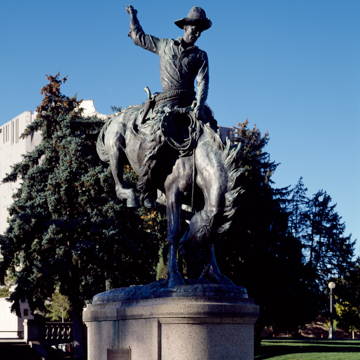Between the City and County Building on the west and the capitol on the east, this park is bounded on the north and south by two classical structures inspired by the 1893 World's Columbian Exposition. Enclosing the north end of the axial crossing, the Voorhies Memorial ( DV008.1; 1919, William E. Fisher and Arthur A. Fisher), 100 West Colfax Avenue, is a modest copy of the Water Gateway to the 1893 fair. An arcade of Turkey Creek sandstone arcs around a pool and a pair of cherub-on-dolphin fountains designed by Denver sculptor Robert Garrison. In the lunettes of the arcade are murals by Allen True depicting bison and elk in the style and colors of antique Greek vases. The memorial was funded by banker and mining entrepreneur John H. P. Voorhies, who lived across the street. The Greek Theater and Colonnade of Civic Benefactors ( DV008.2; 1919, Marean and Norton), West 14th Avenue and Acoma Street, echoes and balances the Voorhies Memorial across the lateral axis of Civic Center. Edward Bennett, the protégé and successor of Daniel Burnham, proposed this despite local critics who complained, “Why the hell does Denver need a Greek theater? We ain't got that many Greeks here!”
The theater's arc responds to the curving wings of the Voorhies Memorial and matches the memorial's Turkey Creek sandstone. Two murals by Allen True, Trapper and Prospector, depict pioneer types in vivid wilderness settings. The north side is terraced down into an open semicircular arena seating 1,200.
Plans for a sunken sculpture garden solidified with two bronze statues by Denverite Alexander Phimister Proctor, Bronco Buster (1920) and On the War Trail (1922). On the east side of the capitol is Closing Era, a bronze Indian and buffalo crafted for the 1893 World's Columbian Exposition by Preston Powers, who once taught in Denver. Newer memorials and sculptures augment, and in some cases clutter, Civic Center Park.








